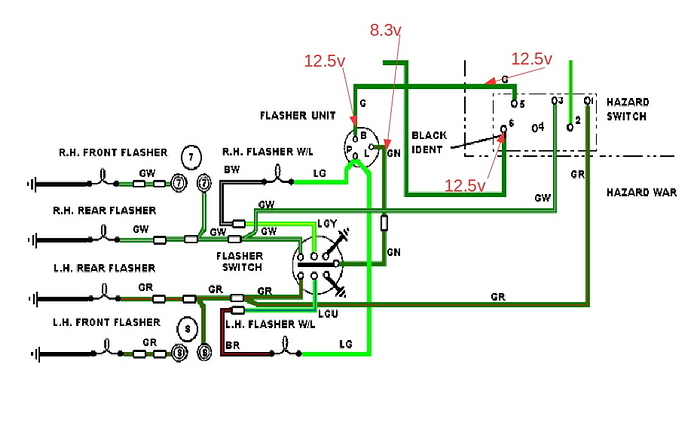Dear Craig,
You haven’t given us the right information before and have been slightly naughty with your “upgrades” - you didn’t say you had LEDs in the warning light holders or that the new flasher was a different type to the other one - this may or may not be relevant.
Remove ALL of the connections from the flasher switch and diagnose what it does when it connects left or right.
The two flasher units are supposedly identical in operation so you ought to be able to swap them over. to help with diagnosing what does and what doesn’t work, especially since you know that the hazard flasher already works.
I would connect the hazard flasher into ordinary flasher position and put ordinary bulbs into the warning lights. Then I’d see what does and doesn’t work when I try to use the indicators in normal use.
Next, to aid my understanding, I’d like to known whether the flasher warning lights are normally supposed to light up when the hazards are being used.
I would then disconnect the flasher switch completely and work out what it does when it is operated and when it is not being used. My guess is that it is supposed to make a connection form LGY (or LGU) to earth AND from GN to GW (or GR) when it moved to the right (left). I am also expecting it to connect GW to LGY and GR to LGU when not being used.
Next - your flasher units. According to the Jaguar diagram, both units appear to be the same, save for maybe their current rating. According to your circuit, one of them is for LEDs, but the other is standard. What you have to appreciate is that LEDs are diodes and conduct in one direction only, but the circuit looks like it wants to light the warning lights with 12v from the flasher unit (earthed at the flasher switch) in normal operation OR light the warning lights with 12v from the GR and GW wires via the hazard switch and LGY/LGU wires and earth them at the flasher unit in hazard operation. Only a normal bulb (or a bidirectional LED) can do this and it is expecting to alternately ground the P terminal of the flasher unit, assuming that the warning lights are supposed to be active when hazards operate. If that is the case, then you’ll have to replace the two warning light bulbs back to ordinary bulbs to make it work.
However, if the warning lights were never intended to light up when using the hazards, I’d expect the flasher switch to not have any connection between GW and LGY or GR to LGU when not in use and that LED bulbs in the warning lights would be fine so long as they are in the right way.
Lastly, why do I have battery voltage on the LG wires? You have battery voltage on the LG wires because they are connected to 12v. You can think of voltages as being like a canal - they are always at the level of the canal, no matter what. When a lock gate is opened, the level of the canal at either side of the gate now equalises to either the higher or lower level, depending on what side of the light/motor/relay they are sitting relative to the two battery terminals. The level of the water drops where the work is being done - on either side of the light/motor/relay winding, but is constant and either 12v or 0v either side of it, depending on the connection. This means that anything that is connected to the battery stays at 12v forever until a circuit is made via a connection to the battery 0v terminal, at which point you’ll see 12v everywhere before where the work is done and 0v after where the work is done.
kind regards
Marek
EDIT:- you appear to be saying that the headlight high beam flasher (the UY wire - previously unmentioned) appears to interfere with the turn/indicator operation (also unhelpfully called “flasher”). You need to clean the indicator stalk inside where the connections are made by the sound of things.



